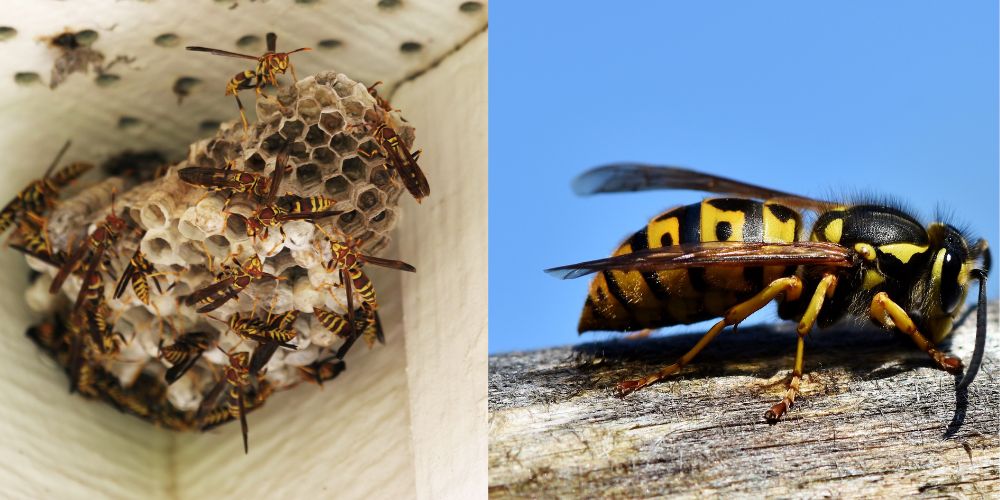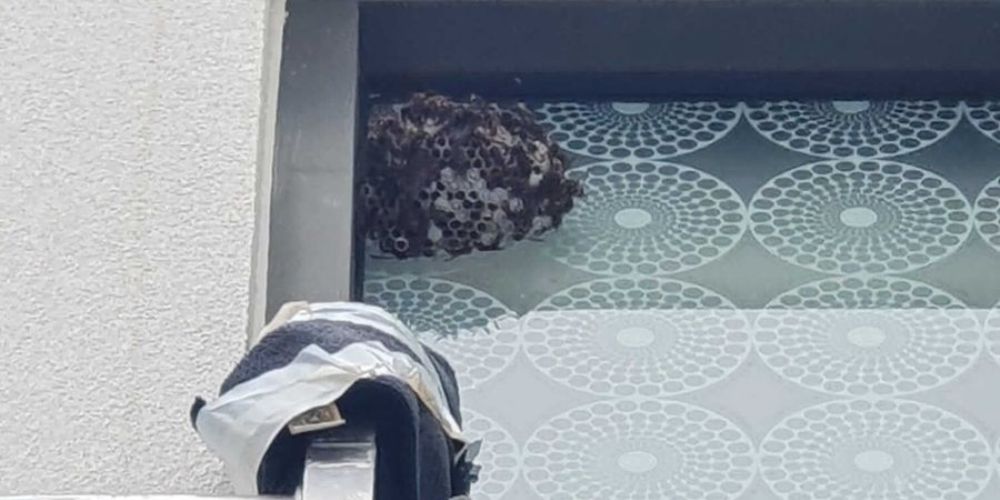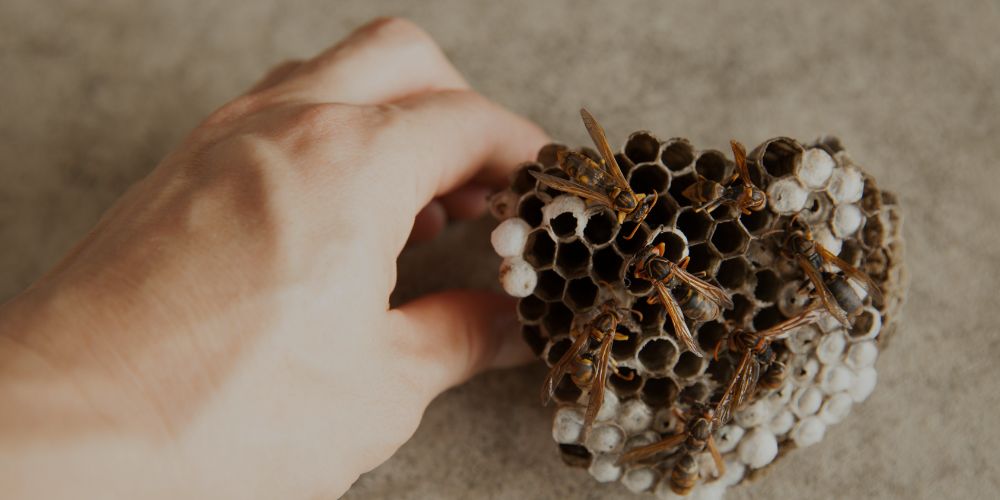Bees and wasps are very useful insects; however, when they build their nests too close to the house or business, they become a real nuisance. No one wants to get a surprise sting or even the idea of dangerous bees swarming near the entrance, porch, or business. It has to be done without hurting the environment or even yourself. Here’s my view on the best ways to approach these buzzing pests.
Understanding the Difference Between Bees and Wasps

It is important to know exactly what you are dealing with before attempting any removal strategies. The fluffy, friendly bees are the real pollinators that are necessary in the food supply, whereas the sleek aggressive wasps seem to attack without much provocation.
Bees should always be relocated rather than exterminated, but with their painful stings and defensive nature, wasps require a more cautious approach. If you are not sure what is making itself at home on your property then take a closer look – just not too close!
Identifying Common Bee and Wasp Nesting Areas
Before removal, it’s important to identify common nesting sites. These include:
- Roof eaves and attic spaces
- Wall cavities and ceilings
- Trees, shrubs, and garden structures
- Balconies, decks, and patios
- Outdoor furniture and commercial premises
Recognizing these nesting areas early can help in implementing timely removal strategies.
Effective Methods for Safe Bee Removal
1. Call a Beekeeper – The Smartest Approach
If you have a bee infestation, do not panic, call a local beekeeper. We know it sounds strange but it is the best decision you can make. They will safely move the hive without hurting the bees so that these important pollinators can keep on doing their job in some other location. Furthermore, it is a win-win situation: you – the bees are gone, and they – have a new place
2. Use Smoke to Encourage Bees to Move
There is an old beekeeper’s trick: smoke. Gentlemen, a small amount of smoke makes bees think that their hive is in danger and they will abandon it. But here’s the thing: if you don’t know what you’re doing, you might just create a bigger problem (or a fire hazard) for yourself. So if you are not sure about your abilities, then this one should be left to the professionals.
3. Block Off Nesting Spots and Remove Attractants
Bees love sweet things and warm, cozy spaces. If you’re constantly dealing with unwanted hives, it’s time to eliminate their favorite hangouts. Seal off cracks in your walls, cover vents, and remove food sources like sugary spills and exposed trash. A little prevention goes a long way.
Effective Methods for Wasp Removal
1. Wasp Traps – A Simple Fix for Small Problems
If you only have a few wasps buzzing around, then wasp traps are the quick fix. They work by luring wasps inside with a sweet bait and then trapping them. But let’s be real, if you’ve got a full-blown nest, a trap won’t do the job. It’s just a temporary measure, not a solution.
2. Natural Repellents – Keep Them Away Without Harm
We don’t have to resort to harsh chemicals when there is a safer way to keep them away. Their oil is also known to keep wasps away and this is done without the use of toxic sprays such as citronella, peppermint and eucalyptus. They are natural repellents that can be used to make wasps not to make their nests in some regions. In addition, they are environmentally friendly and can be used both in homes and businesses without any side effects and they have a very pleasant smell.
3. Professional Wasp Nest Removal – The Only Safe Choice for Large Infestations
Wasps don’t play around when their home is under attack. If you’ve got a big nest, don’t even think about knocking it down yourself. One wrong move, and you could have an angry swarm chasing you. Calling in a professional wasp removal service ensures the job is done safely and effectively.
Also Read – Comprehensive Guide to Fall Protection Systems
Bee and Wasp Removal for Different Spaces
Residential Bee and Wasp Removal

Oh yes, nobody wants to find a wasp nest under your deck, or a beehive near your windows. If you have kids or pets, then you should act fast. Blocking entry points, using natural repellents and scheduling professional inspections can go a long way in keeping your home safe. And, regular garden maintenance can keep those unwanted guests from ever making your home their home.
Commercial Bee and Wasp Removal

For businesses, a bee or wasp infestation is not only a nuisance– it is a liability. No business can allow its employees or customers to be stung. Safety protocols such as professional pest control and regular property inspections are absolute necessities to keep your property safe and running.
Pest Control Solutions for Bees and Wasps
But sometimes, no amount of DIY tricks are going to cut it. When bees and wasps keep returning, it is time to call in the experts. Using integrated pest management (IPM) techniques, professional pest control services to remove the problem safely and to prevent future infestations. I’m telling you, if you are dealing with a persistent problem, getting expert help is the right decision.
The Role of Bird Spikes in Preventing Infestations
You may not consider bird spikes as a control measure for bees and wasps but let me explain. To prevent the insects from making their nests, which they usually do in roof edges and ledges, among other places, you can put bird spikes. It is a simple method of not only excluding birds but also other pests from your space.
Preventing Future Infestations
1. Regular Inspections and Maintenance
You shouldn’t ignore a leaking pipe before it floods your house, so don’t wait until you have an infestation before taking action. Check for signs of bee and wasp nests and stop them early, you shouldn’t ignore this.
2. Keep Trash Sealed and Food Covered
Yes, wasps are interested in the open garbage and sugary drinks. It is very important that your trash cans are closed and that you do not leave food lying around. It may seem like a small action, but it is one of those steps that do count a lot.
3. Use Fake Wasp Nests to Deter New Colonies
Here’s a cool trick-wasps are highly territorial. Hanging a fake wasp nest in your outdoor area can trick them into thinking the space is already claimed, preventing them from settling in.
Conclusion
Getting rid of bees and wasps doesn’t have to be a nightmare. If you have bees, then you should have them relocated by a professional. Wasps need a combination of deterrents, traps, and either a DIY or professional intervention. You don’t want to try and fix this at home if it’s your home or business; it’s better to prevent it than to try and fix it (and get stung) at a later time. If you need expert help, Rope Access Australia offers professional bee and wasp removal services to keep your property safe-don’t hesitate to call us.




